SNAKES IN THE AMAZONEver since the first outsider set foot in the Amazon, the world has been subjected to countless lurid tales of a Green Hell teeming with slithering snakes, each capable of recognizing a human and all determined to maim and kill. Aside from being demonstrably untrue at all levels, this approach reflects a basic flaw in our way of viewing nature. The world is filled with hazards—your computer might blow up as you read this—and each has a risk factor, that is, how likely it is to occur, attached to it. The science of risk analysis has been responsible for most aspects of life in the developed world and it is why things tend to function safely and efficiently. Yet we have never approached the world of animals in this manner so a risk factor of 100% is assigned to anything potentially negative that a wild animal might be capable of doing to a human.While this absurdity has made things lucrative for Hollywood, and has titillated a generation of couch potatoes who do not realize that most of what they are watching is fiction, it also has fueled the continuing bias that has made things difficult for the Amazon and its fragile wildlife. High-risk factors in the Amazon are things like drowning, getting lost, slipping and falling, getting sunburned, etc. The low-risk items like being attacked by jaguars, consumed by piranhas, squeezed by anacondas, or bitten by a venomous snake provide the fodder for films, “documentaries,” and books. Despite all tales to the contrary, snakes do not attack, are not aggressive (unless you count vigorously defending themselves when scared or hurt) and haven’t a clue as to what a human being might be. An honest film about high-risk hazards in the Amazon Basin would feature cars, motorcycles, and trucks to the exclusion of all else. Working with reptiles and amphibians is what brought us to the Amazon in the first place and here we are some 35 years later, still going after them. It is a shame that fear and ignorance about these creatures have, if anything increased during this time. GreenTracks has taken hundreds of people into the Amazon during the past 18 years and we have never had any problems. In fact, we can state unequivocally that finding snakes in the Amazon is much more difficult that it is in the US or Europe. What the Amazon does have is what biologists call a high degree of species richness, that is, the numbers of different kinds of things. So, while it is difficult to even see a snake, it is even more difficult to see two or more of the same kind because there are so many different kinds present.The part of the Amazon Basin we visit is home to seventeen species of dangerously venomous snakes, of which seven are pitvipers and ten are coralsnakes. The pitvipers include the infamous Bushmaster (Lachesis muta), the largest venomous snake in the Western Hemisphere and an animal that is feared and revered. There are almost no bites recorded on humans from this uncommon and shy animal. Another pitviper, the unimpressive, 3-foot-long South American Lancehead or Fer-de-Lance (Bothrops atrox), however, is responsible for 99% of all human envenoming in the entire Amazon Basin.Coralsnakes, which range from the 15-inch Black-backed Coralsnake (Micrurus scutiventris) to the nearly six-foot Spix’s coralsnake (Micrurus spixii) tend to be colorful and they are extremely shy, seldom venturing from the safety of leaf litter out onto the surface of the ground and thus not often seen by humans. We are aware of two coralsnake bites in the entire upper Amazon region. Just to complicate things, Mother Nature has larded the area with beautifully ringed but entirely harmless snakes that look like coralsnakes. And for every venomous snake species there are about seven kinds of harmless ones. Here we share a few images of venomous snakes from the Amazon….. Aquatic Coralsnake
Aquatic Coralsnake (
Micrurus surinamensis). One of the longest and easily the bulkiest of all coralsnakes, this placid reptile feeds on knife fish and possess venom so toxic it can kill its prey instantly. Fortunately they never bother humans!
 Slender Coralsnake
Slender Coralsnake (
Micrurus filiformis). This brightly colored snake lives in leaf litter near flood forests so rising waters often make it swim for higher land, leading many to mistakenly think it prefers the water.
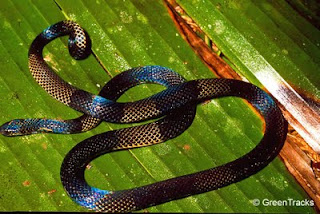 Putumayo Coralsnake (Micrurus putumayensis)
Putumayo Coralsnake (Micrurus putumayensis). This essentially black and yellow snake lives along the southern border of the Amazon River and is one of the least known coralsnake species.
 Langsdorff's Coralsnake (Micrurus langsdorffi)
Langsdorff's Coralsnake (Micrurus langsdorffi). Not only are Latin American coralsnakes more variable than those in the United States, but also they sometimes lack black rings altogether.
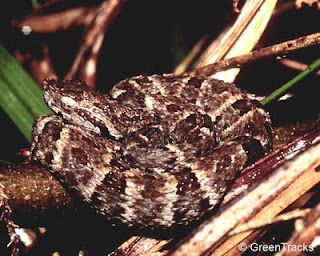 South American Lancehead (Bothrops atrox)
South American Lancehead (Bothrops atrox). This rather unimposing pitviper is the most important—and almost the only—source of venomous snakebite throughout its range, which includes the entire Amazon Basin. The problem is that it is adaptable and will take advantage of the trash piles humans leave near their homes as this attracts rodents and other food items.
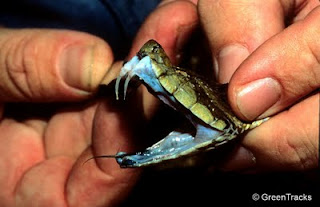 The business end of a pitviper. These snakes possess a sophisticated means of detecting prey (thermo receptive pits) and flexible hollow fangs which function like the invention they inspired: the hypodermic needle.
The business end of a pitviper. These snakes possess a sophisticated means of detecting prey (thermo receptive pits) and flexible hollow fangs which function like the invention they inspired: the hypodermic needle. Amazonian Toadheaded Pitviper (Bothrocophias hyoprora). This small pitviper is so sluggish it seldom moves and is rarely seen by humans. Like all terrestrial pitvipers, its colors and pattern blend with the leaf litter of the forest floor.
Amazonian Toadheaded Pitviper (Bothrocophias hyoprora). This small pitviper is so sluggish it seldom moves and is rarely seen by humans. Like all terrestrial pitvipers, its colors and pattern blend with the leaf litter of the forest floor. Inca Forest-pitviper (Bothriopsis chloromelas). Who says snakes can’t be beautiful? This gaudy reptile lives in cloud forests and along mountain slopes in Peru and likely in Ecuador.
Inca Forest-pitviper (Bothriopsis chloromelas). Who says snakes can’t be beautiful? This gaudy reptile lives in cloud forests and along mountain slopes in Peru and likely in Ecuador.
 South American Bushmaster (Lachesis muta). Bushmasters are the longest venomous snakes in the Western Hemisphere and they possess a largely undeserved reputation for malice.
South American Bushmaster (Lachesis muta). Bushmasters are the longest venomous snakes in the Western Hemisphere and they possess a largely undeserved reputation for malice. 
South American Bushmaster flicks its tongue. Snakes use their tongues as important sense organs that provide them with information about their surroundings
 Kids, don’t try this at home! All joking aside, a fully aroused bushmaster is a redoubtable foe. Fortunately they are usually lethargic, but handling them in any fashion is a job best left to the experienced.
Kids, don’t try this at home! All joking aside, a fully aroused bushmaster is a redoubtable foe. Fortunately they are usually lethargic, but handling them in any fashion is a job best left to the experienced.
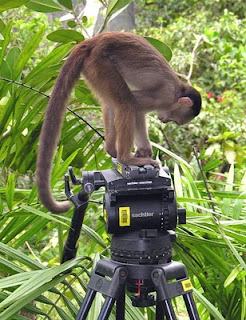

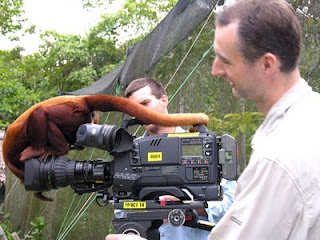




 If you ever wondered how they do those slow-motion rotating shots around a character, as in the Matrix films, this is how it is done - with videos cameras on each end of a set of still cameras.
If you ever wondered how they do those slow-motion rotating shots around a character, as in the Matrix films, this is how it is done - with videos cameras on each end of a set of still cameras.






 If you ever wondered how they do those slow-motion rotating shots around a character, as in the Matrix films, this is how it is done - with videos cameras on each end of a set of still cameras.
If you ever wondered how they do those slow-motion rotating shots around a character, as in the Matrix films, this is how it is done - with videos cameras on each end of a set of still cameras.
 Masked Crimson Tanager Ramphocelus nigrogularis. Peru has a richness of magnificently colored tanagers and fortunately many are conspicuous inhabitants of pasture land and other areas of secondary growth.
Masked Crimson Tanager Ramphocelus nigrogularis. Peru has a richness of magnificently colored tanagers and fortunately many are conspicuous inhabitants of pasture land and other areas of secondary growth. Cream-colored Woodpecker Celeus flavus. This unmistakable beauty is best located along river margins and in swamp forest.
Cream-colored Woodpecker Celeus flavus. This unmistakable beauty is best located along river margins and in swamp forest. Barred Forest Falcon Micrastur ruficollis. Although forest falcons are difficult to observe they may be the most dominant predatory bird group in the Peruvian Amazon where no fewer than five species can be found.
Barred Forest Falcon Micrastur ruficollis. Although forest falcons are difficult to observe they may be the most dominant predatory bird group in the Peruvian Amazon where no fewer than five species can be found. Wattled Curassow Crax globulosa. Curassows are the size of turkeys and as such are hunted for food. Most of them are now restricted to the more remote regions of forest. Interestingly, locals examine their crops for gold flecks the big birds consume.
Wattled Curassow Crax globulosa. Curassows are the size of turkeys and as such are hunted for food. Most of them are now restricted to the more remote regions of forest. Interestingly, locals examine their crops for gold flecks the big birds consume. Blue and yellow Macaw Ara ararauna. Macaws rank among the most spectacular and noticeable of Amazonian birds and a raucous flock of Blue and yellow Macaws makes for an unforgettable sight.
Blue and yellow Macaw Ara ararauna. Macaws rank among the most spectacular and noticeable of Amazonian birds and a raucous flock of Blue and yellow Macaws makes for an unforgettable sight. Scarlet Macaw Ara macao. The classic pirate’s pet, Scarlet macaws are familiar the world over. Sometimes we see mixed flocks of Scarlet with Blue and yellow macaws. It looks like an airborne (and noisy!) festival when they fly over our boat.
Scarlet Macaw Ara macao. The classic pirate’s pet, Scarlet macaws are familiar the world over. Sometimes we see mixed flocks of Scarlet with Blue and yellow macaws. It looks like an airborne (and noisy!) festival when they fly over our boat. Ferruginous Pygmy-owl Glaucidium brasilianum. One of the smallest owls in the country, this tiny predator is often active by day. It prefers riverside and swamp forests and second-growth. The distinctive call is often heard just prior to dawn.
Ferruginous Pygmy-owl Glaucidium brasilianum. One of the smallest owls in the country, this tiny predator is often active by day. It prefers riverside and swamp forests and second-growth. The distinctive call is often heard just prior to dawn. Hoatzin Opisthocomus hoatzin. This bizarre bird is in its own family. It is herbivorous and the newly hatched young can swim and have claws on their wings to help them climb back into the spiny palms where these strange creatures nest.
Hoatzin Opisthocomus hoatzin. This bizarre bird is in its own family. It is herbivorous and the newly hatched young can swim and have claws on their wings to help them climb back into the spiny palms where these strange creatures nest. Pied Lapwing Vanellus cayanus. This boldly colored plover is a fairly common resident along sandy beaches and adjacent open areas.
Pied Lapwing Vanellus cayanus. This boldly colored plover is a fairly common resident along sandy beaches and adjacent open areas. Sun Bittern Europyga helias. This interesting bird hunts for food along streams, rivers and the edges of forest lakes. When threatened it spreads and raises the wings exposing a pair of imposing eye spots.
Sun Bittern Europyga helias. This interesting bird hunts for food along streams, rivers and the edges of forest lakes. When threatened it spreads and raises the wings exposing a pair of imposing eye spots. We are offering a special 30% discount on selected departures in January on both the Delfin I and Delfin II.
We are offering a special 30% discount on selected departures in January on both the Delfin I and Delfin II. As you cruise between Belem, near the mouth of the Amazon on the Atlantic, along the wide snaking length of the world’s longest river, deep into sinuous tributaries and flooded forests, to Iquitos in the Peruvian rain forest, you will have the opportunity to see and experience all the incredible sights Amazonia offers. In addition to our own onboard expert naturalist guides, we are privileged to have on these expeditions a stellar team of lecturers
As you cruise between Belem, near the mouth of the Amazon on the Atlantic, along the wide snaking length of the world’s longest river, deep into sinuous tributaries and flooded forests, to Iquitos in the Peruvian rain forest, you will have the opportunity to see and experience all the incredible sights Amazonia offers. In addition to our own onboard expert naturalist guides, we are privileged to have on these expeditions a stellar team of lecturers Read more...
Read more... M/V Ayapua
M/V Ayapua M/V Clavero
M/V Clavero Delfin I
Delfin I
 Aquatic Coralsnake (Micrurus surinamensis). One of the longest and easily the bulkiest of all coralsnakes, this placid reptile feeds on knife fish and possess venom so toxic it can kill its prey instantly. Fortunately they never bother humans!
Aquatic Coralsnake (Micrurus surinamensis). One of the longest and easily the bulkiest of all coralsnakes, this placid reptile feeds on knife fish and possess venom so toxic it can kill its prey instantly. Fortunately they never bother humans! Slender Coralsnake (Micrurus filiformis). This brightly colored snake lives in leaf litter near flood forests so rising waters often make it swim for higher land, leading many to mistakenly think it prefers the water.
Slender Coralsnake (Micrurus filiformis). This brightly colored snake lives in leaf litter near flood forests so rising waters often make it swim for higher land, leading many to mistakenly think it prefers the water. Putumayo Coralsnake (Micrurus putumayensis). This essentially black and yellow snake lives along the southern border of the Amazon River and is one of the least known coralsnake species.
Putumayo Coralsnake (Micrurus putumayensis). This essentially black and yellow snake lives along the southern border of the Amazon River and is one of the least known coralsnake species. Langsdorff's Coralsnake (Micrurus langsdorffi). Not only are Latin American coralsnakes more variable than those in the United States, but also they sometimes lack black rings altogether.
Langsdorff's Coralsnake (Micrurus langsdorffi). Not only are Latin American coralsnakes more variable than those in the United States, but also they sometimes lack black rings altogether. South American Lancehead (Bothrops atrox). This rather unimposing pitviper is the most important—and almost the only—source of venomous snakebite throughout its range, which includes the entire Amazon Basin. The problem is that it is adaptable and will take advantage of the trash piles humans leave near their homes as this attracts rodents and other food items.
South American Lancehead (Bothrops atrox). This rather unimposing pitviper is the most important—and almost the only—source of venomous snakebite throughout its range, which includes the entire Amazon Basin. The problem is that it is adaptable and will take advantage of the trash piles humans leave near their homes as this attracts rodents and other food items. The business end of a pitviper. These snakes possess a sophisticated means of detecting prey (thermo receptive pits) and flexible hollow fangs which function like the invention they inspired: the hypodermic needle.
The business end of a pitviper. These snakes possess a sophisticated means of detecting prey (thermo receptive pits) and flexible hollow fangs which function like the invention they inspired: the hypodermic needle. Amazonian Toadheaded Pitviper (Bothrocophias hyoprora). This small pitviper is so sluggish it seldom moves and is rarely seen by humans. Like all terrestrial pitvipers, its colors and pattern blend with the leaf litter of the forest floor.
Amazonian Toadheaded Pitviper (Bothrocophias hyoprora). This small pitviper is so sluggish it seldom moves and is rarely seen by humans. Like all terrestrial pitvipers, its colors and pattern blend with the leaf litter of the forest floor. Inca Forest-pitviper (Bothriopsis chloromelas). Who says snakes can’t be beautiful? This gaudy reptile lives in cloud forests and along mountain slopes in Peru and likely in Ecuador.
Inca Forest-pitviper (Bothriopsis chloromelas). Who says snakes can’t be beautiful? This gaudy reptile lives in cloud forests and along mountain slopes in Peru and likely in Ecuador. South American Bushmaster (Lachesis muta). Bushmasters are the longest venomous snakes in the Western Hemisphere and they possess a largely undeserved reputation for malice.
South American Bushmaster (Lachesis muta). Bushmasters are the longest venomous snakes in the Western Hemisphere and they possess a largely undeserved reputation for malice.  South American Bushmaster flicks its tongue. Snakes use their tongues as important sense organs that provide them with information about their surroundings
South American Bushmaster flicks its tongue. Snakes use their tongues as important sense organs that provide them with information about their surroundings Kids, don’t try this at home! All joking aside, a fully aroused bushmaster is a redoubtable foe. Fortunately they are usually lethargic, but handling them in any fashion is a job best left to the experienced.
Kids, don’t try this at home! All joking aside, a fully aroused bushmaster is a redoubtable foe. Fortunately they are usually lethargic, but handling them in any fashion is a job best left to the experienced.